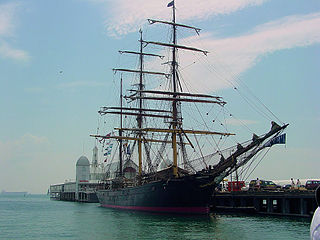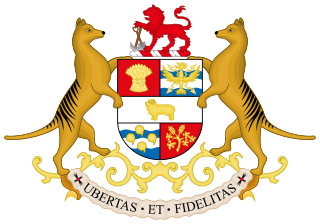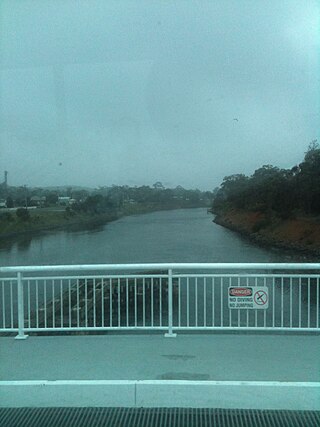
James Craig is a three-masted, 19th century iron-hulled barque restored and sailed by the Sydney Heritage Fleet, Sydney, Australia. She is one of only four pre-20th century barques in the world that still go regularly to sea.

The Parliament of Tasmania is the bicameral legislature of the Australian state of Tasmania. It follows a Westminster-derived parliamentary system and consists of the governor of Tasmania, the Legislative Council, and the House of Assembly. Since 1841, the Legislative Council has met in Parliament House, Hobart, with the House of Assembly following suit from its establishment in 1856. The Parliament of Tasmania first met in 1856.

Sullivans Cove is on the River Derwent adjacent to the Hobart City Centre in Tasmania. It was the site of initial European settlement in the area, and the location of the earlier components of the Port of Hobart.

Incat Tasmania is an Australian manufacturer of high-speed craft (HSC) catamaran ferries. Its greatest success has been with large, sea going passenger and vehicle ferries, but it has also built military transports and since 2015 it has built smaller river and bay ferries. Based in Derwent Park, a suburb of Hobart, Tasmania, Australia, it was founded by Bob Clifford.

South West Cape is a cape located at the south-west corner of Tasmania, Australia. The cape is situated in the south-western corner of the Southwest National Park, part of the Tasmanian Wilderness World Heritage Area, approximately 140 kilometres (87 mi) southwest of Hobart in Tasmania, and about 65 kilometres (40 mi) west and slightly north of South East Cape.

The Australian National Maritime Museum (ANMM) is a federally operated maritime museum in Darling Harbour, Sydney. After considering the idea of establishing a maritime museum, the federal government announced that a national maritime museum would be constructed at Darling Harbour, tied into the New South Wales state government's redevelopment of the area for the Australian bicentenary in 1988. The museum building was designed by Philip Cox, and although an opening date of 1988 was initially set, construction delays, cost overruns, and disagreements between the state and federal governments over funding responsibility pushed the opening to 1991.

SAIL Amsterdam is a maritime event held once every five years in Amsterdam in the Netherlands. Tall ships from all over the world visit the city to moor in its eastern harbour. The 2020 event was cancelled due to the COVID-19 pandemic.

Government House, Hobart, is the home and official residence of the governor of Tasmania, Australia. The palatial house is located on Lower Domain Road in the Queens Domain, near the Royal Tasmanian Botanical Gardens. There have been three Government Houses, all in Hobart.

Australian National Line (ANL) was a coastal shipping line established by the Government of Australia in 1956. It was sold in 1998 by the Howard government to CMA CGM.

The Royal Hobart Regatta is a series of aquatic competitions and displays held annually in Hobart, Tasmania, Australia and is Tasmania's oldest sporting event. The regatta began in 1838.

The Tasmanian Museum and Art Gallery (TMAG) is a museum located in Hobart, Tasmania. The museum was established in 1846, by the Royal Society of Tasmania, the oldest Royal Society outside England. The TMAG receives 400,000 visitors annually.

The SV Tenacious is a modern British wooden sail training ship, specially designed in the 1990s. When completed in 2000, it was the largest wooden ship to be built in the UK for over 100 years.
Argo was a merchant ship built in 1806 at Chittagong, present-day Bangladesh. She was registered in Calcutta to Payne & Tyrce. She disappeared in 1814 off the coast of Tasmania after having been "run away with" by convicts.

Smooth Island, is a privately owned island with an area of 59.31 ha lying close to the south-eastern coast of Tasmania, Australia. The island is part of the Sloping Island Group situated in Norfolk Bay and surrounded by the Tasman and Forestier Peninsulas. The towns Dunalley and Murdunna are nearby. Smooth Island differs from other Tasmanian islands as it has an unencumbered freehold title down to the high-water mark.

The Taste of Summer Festival, previously known as the Taste of Tasmania, is an annual event held in Hobart, Tasmania, from 27 December to 6 January. The festival includes over 75 stalls featuring local breweries, distilleries, wineries, and eateries, drawing in both locals and tourists from around the globe. Hosted at Princes Wharf Nº1, adjacent to the historic Salamanca Place, the festival coincides with the State's peak of the tourism season. Additionally, Hobart's waterfront is the place where New Year's Eve festivities are celebrated, including the Sydney to Hobart Yacht Race, "one of the world’s greatest, and hardest, offshore races," as described by The New York Times. Visitors have the opportunity to taste the Tasmanian cuisine and beverages while enjoying live music and entertainment provided by a diverse selection of interstate performers. The event serves as an example of the significant role tourism plays in the economy of Australia. Beyond offering a platform for displaying local products, Taste of Summer generates socio-economic benefits such as job creation and amplifies the region's food and wine industry. Also, the active participation of the community in organising, managing, and providing entertainment emphasize their role in economic development. The diversity of Taste of Summer allows interconnection within the communities through "employment, volunteerism, networks and participation."

The Denison Canal is a human-made canal located at Dunalley in southern Tasmania, Australia. The canal opened for use in 1905 and draws its name from former Governor William Denison. The canal was built to shorten the fishing and trade routes between the east coast and Hobart.

HMS Endeavour replica is a replica of HMS Endeavour, the bark commanded by Lieutenant James Cook when he charted New Zealand and the eastern coast of Australia.

Victoria Dock, in Hobart, Tasmania, Australia, is a key dock for Australian Antarctic supply vessels and one of the oldest docks in Tasmania.
The Tasmanian Seafarers' Memorial is a public memorial structure located at Triabunna, Tasmania which jointly commemorates all Tasmanians who died at sea, along with the lives of all seafarers of any origin who lost their lives in Tasmanian waters. The memorial comprises individual commemorative plaques for each maritime tragedy involving recreational, commercial, mercantile or naval vessels and personnel lost since 1803. As of February 2017, the memorial contained plaques for 116 events involving the loss of over 1450 lives.
The COVID-19 pandemic in Tasmania is part of the ongoing worldwide pandemic of the coronavirus disease 2019 caused by severe acute respiratory syndrome coronavirus 2.

















